instrument panel lexus LFA 2012 Technical Information / LEXUS 2012 LFA OWNERS MANUAL (OM77006U)
[x] Cancel search | Manufacturer: LEXUS, Model Year: 2012, Model line: LFA, Model: Lexus LFA 2012Pages: 420, PDF Size: 5.02 MB
Page 14 of 420
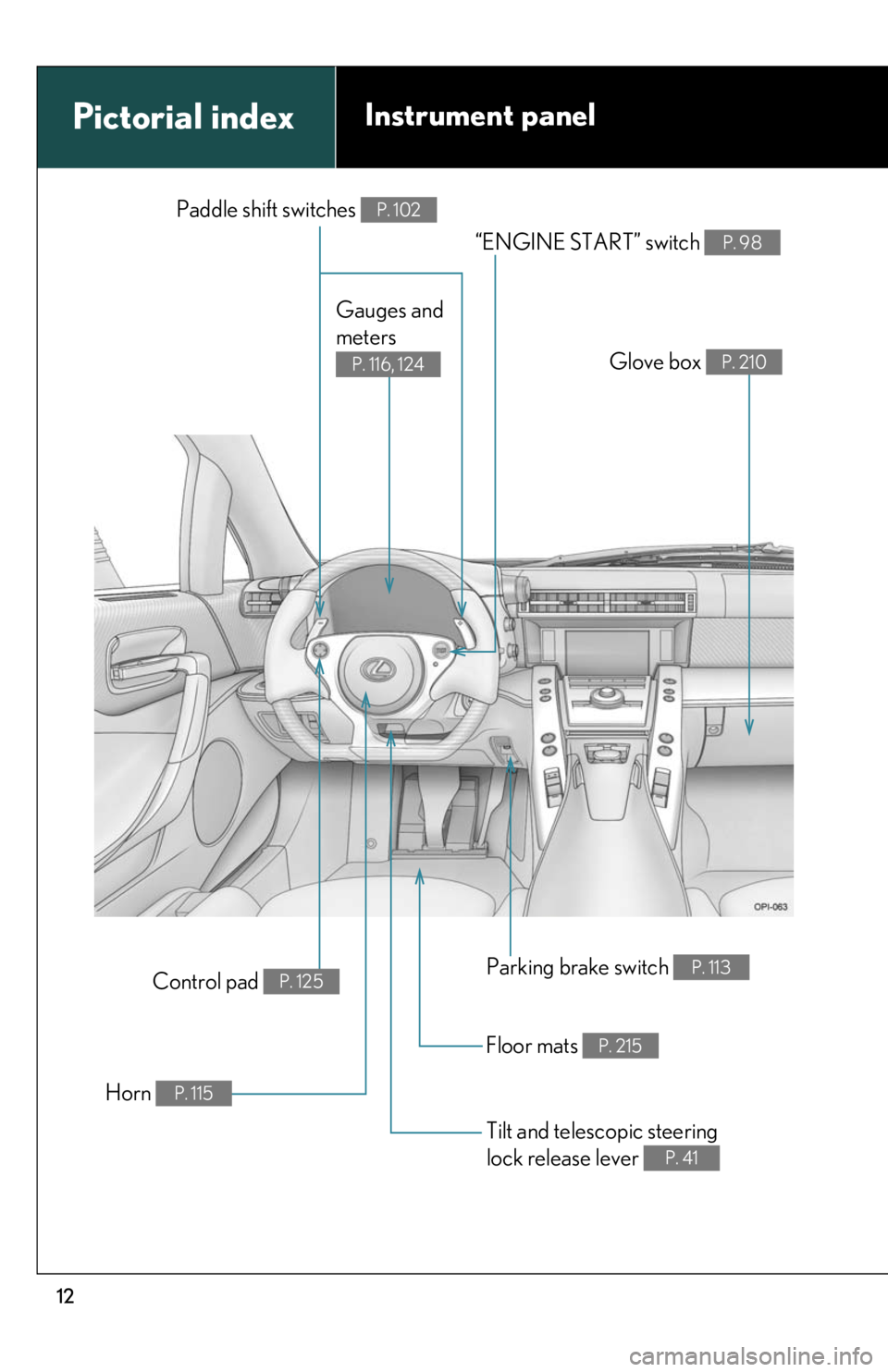
12
Pictorial index
Gauges and
meters
P. 116, 124
Paddle shift switches P. 102
“ENGINE START” switch P. 98
Glove box P. 210
Floor mats P. 215
Parking brake switch P. 113
Tilt and telescopic steering
lock release lever
P. 41
Horn P. 115
Instrument panel
Control pad P. 125
Page 16 of 420
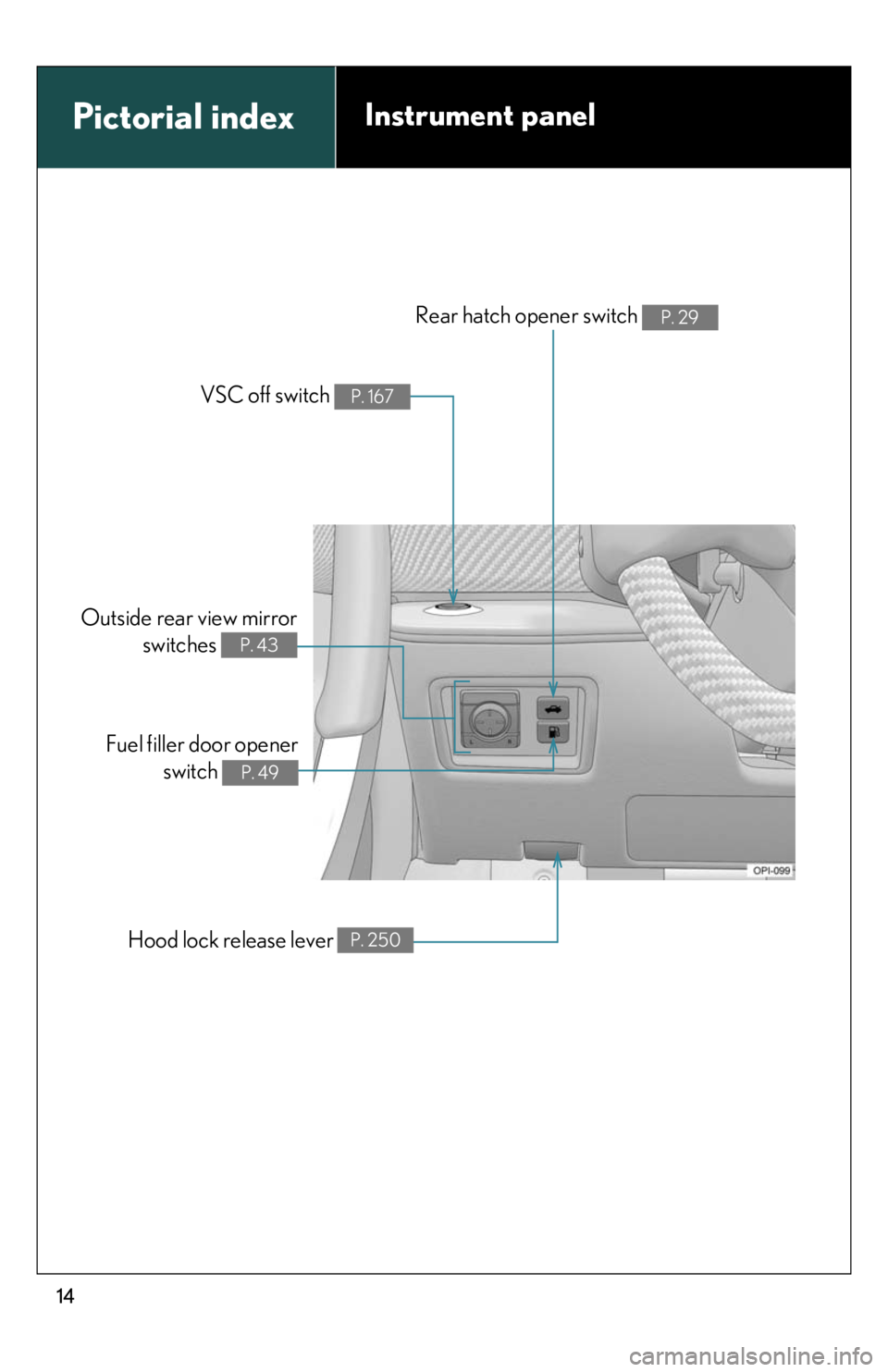
14
Pictorial indexInstrument panel
Fuel filler door openerswitch
P. 49
Hood lock release lever P. 250
VSC off switch P. 167
Rear hatch opener switch P. 29
Outside rear view mirror switches
P. 43
Page 69 of 420
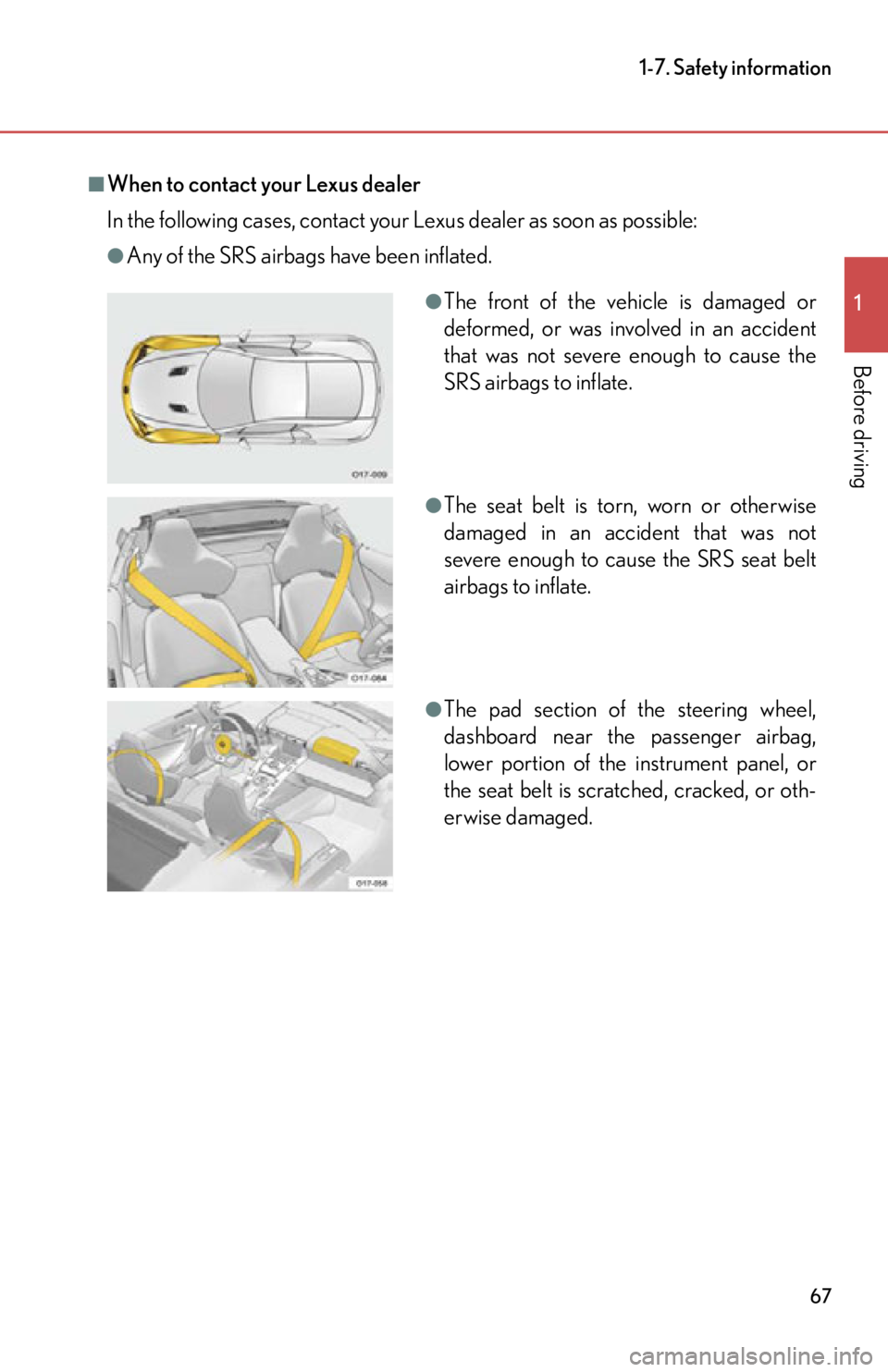
67
1-7. Safety information
1
Before driving
■When to contact your Lexus dealer
In the following cases, contact your Lexus dealer as soon as possible:
●Any of the SRS airbags have been inflated.
●The front of the vehicle is damaged or
deformed, or was involved in an accident
that was not severe enough to cause the
SRS airbags to inflate.
●The seat belt is torn, worn or otherwise
damaged in an accident that was not
severe enough to cause the SRS seat belt
airbags to inflate.
●The pad section of the steering wheel,
dashboard near the passenger airbag,
lower portion of the instrument panel, or
the seat belt is scratched, cracked, or oth-
erwise damaged.
Page 70 of 420

68
1-7. Safety information
CAUTION
■SRS airbag precautions
Observe the following precautions regarding the airbags.
Failure to do so may cause death or serious injury.
●The driver and passenger in the vehicle must wear their seat belts properly.
The SRS airbags are supplemental devices to be used with the seat belts.
●The SRS driver airbag deploys with considerable force, and can cause death or
serious injury especially if the driver is very close to the airbag. The National
Highway Traffic Safety Administration (“NHTSA”) advises:
Since the risk zone for the driver airbag is the first 2 - 3 in. (50 - 75 mm) of infla-
tion, placing yourself 10 in. (250 mm) from your driver airbag provides you with a
clear margin of safety. This distance is measured from the center of the steering
wheel to your breastbone. If you sit less than 10 in. (250 mm) away now, you can
change your driving position in several ways:
• Move your seat to the rear as far as you can while still reaching the pedals
comfortably.
• Slightly recline the back of the seat. Although vehicle designs vary, many dr ivers can achieve the 10 in. (250 mm)
distance, even with the driver’s seat all the way forward, simply by reclining
the back of the seat somewhat. If reclining the back of your seat makes it hard
to see the road, raise yourself by using a firm, or raise the seat if your vehicle
has that feature.
• If your steering wheel is adjustable, ti lt it downward. This points the airbag
toward your chest instead of your head and neck.
The seat should be adjusted as recommended by NHTSA above, while still main-
taining control of the foot pedals, steering wheel, and your view of the instrument
panel controls.
Page 71 of 420

69
1-7. Safety information
1
Before driving
CAUTION
■SRS airbag precautions
●The SRS passenger airbag also deploys with considerable force, and can cause
death or serious injury especially if the passenger is very close to the airbag. The
passenger seat should be as far from the airbag as possible with the seatback
adjusted, so the passenger sits upright.
●Improperly seated and/or restrained infants and children can be killed or seri-
ously injured by a deploying airbag. An infant or child who is too small to use a
seat belt should be properly secured using a child restraint system. Lexus strongly
recommends that all infants and children be properly restrained. The rear seats
are the safest for infants and children. ( P. 76 )
●Do not sit on the edge of the seat or lean
against the dashboard.
●Do not allow a child to stand in front of the
SRS passenger airbag unit or sit on the
knees of a passenger.
●Do not drive the vehicle while the driver or
passenger have items resting on their
knees.
●Do not attach anything to or lean anything
against areas such as the dashboard, steer-
ing wheel pad, seat belt, or lower portion of
the instrument panel.
These items can become projectiles when
SRS driver, passenger, seat belt and knee
airbags deploy.
Page 73 of 420

71
1-7. Safety information
1
Before driving
CAUTION
■Modification and disposal of SRS airbag system components
Do not dispose of your vehicle or perform any of the following modifications with-
out consulting your Lexus dealer.
The SRS airbags may malfunction or deploy (inflate) accidentally, causing death or
serious injury.
●Installation, removal, disassembly and repair of the SRS airbags.
●Repairs, modifications, removal or replace ment of the steering wheel, instrument
panel, dashboard or seat belt.
●Repairs or modifications of the front fender or front bumper.
●Installation of snow plows, winches, etc. to the front grille (bull bars, kangaroo bar
etc.).
●Modifications to the vehi cle's suspension system.
●Installation of electronic devices such as mobile two-way radios or CD players.
●Modifications to your vehicle for a person with a physical disability.
Page 123 of 420
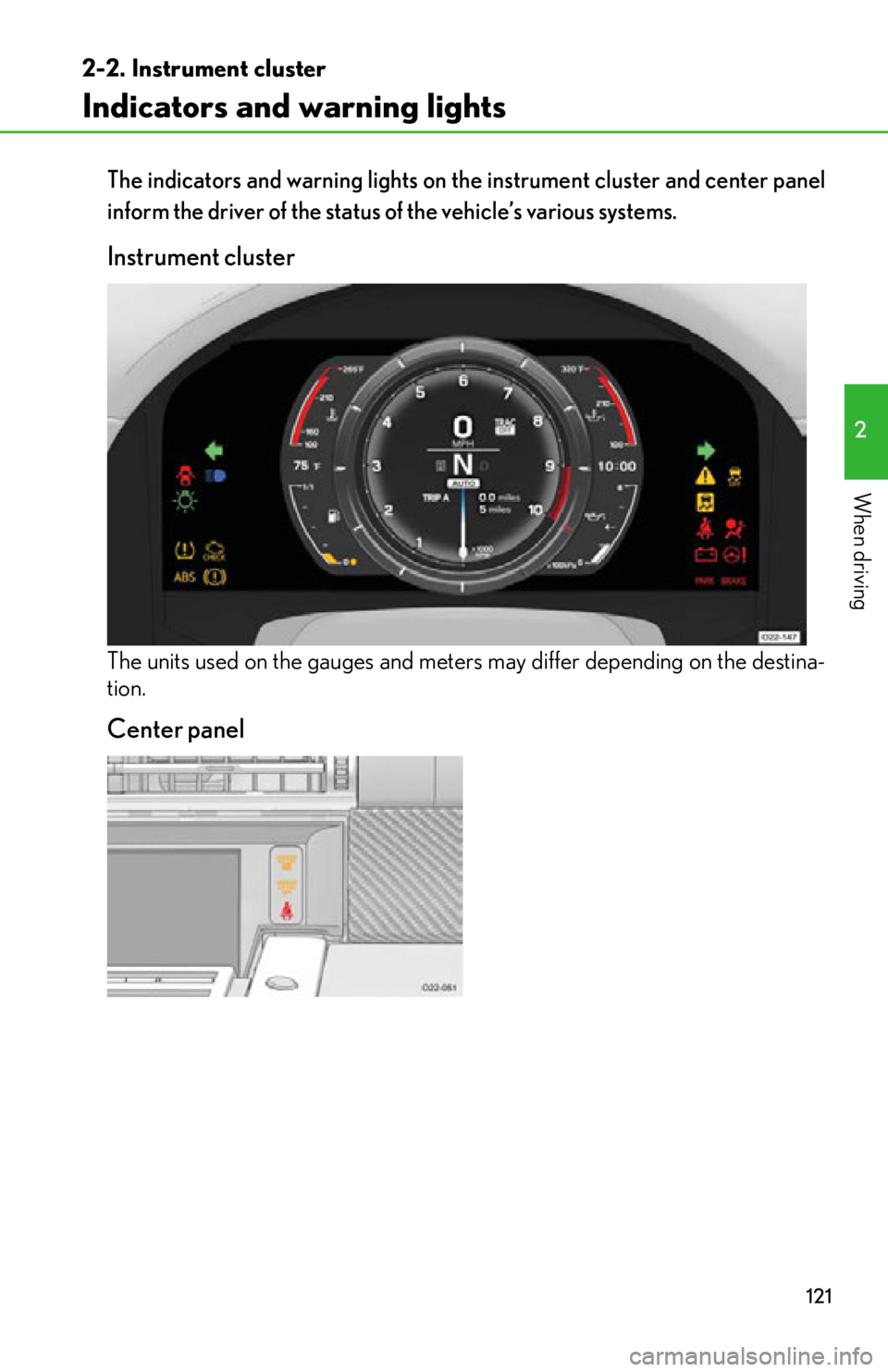
121
2-2. Instrument cluster
2
When driving
Indicators and warning lights
The indicators and warning lights on the instrument cluster and center panel
inform the driver of the status of the vehicle’s various systems.
Instrument cluster
The units used on the gauges and meters may differ depending on the destina-
tion.
Center panel
Page 149 of 420
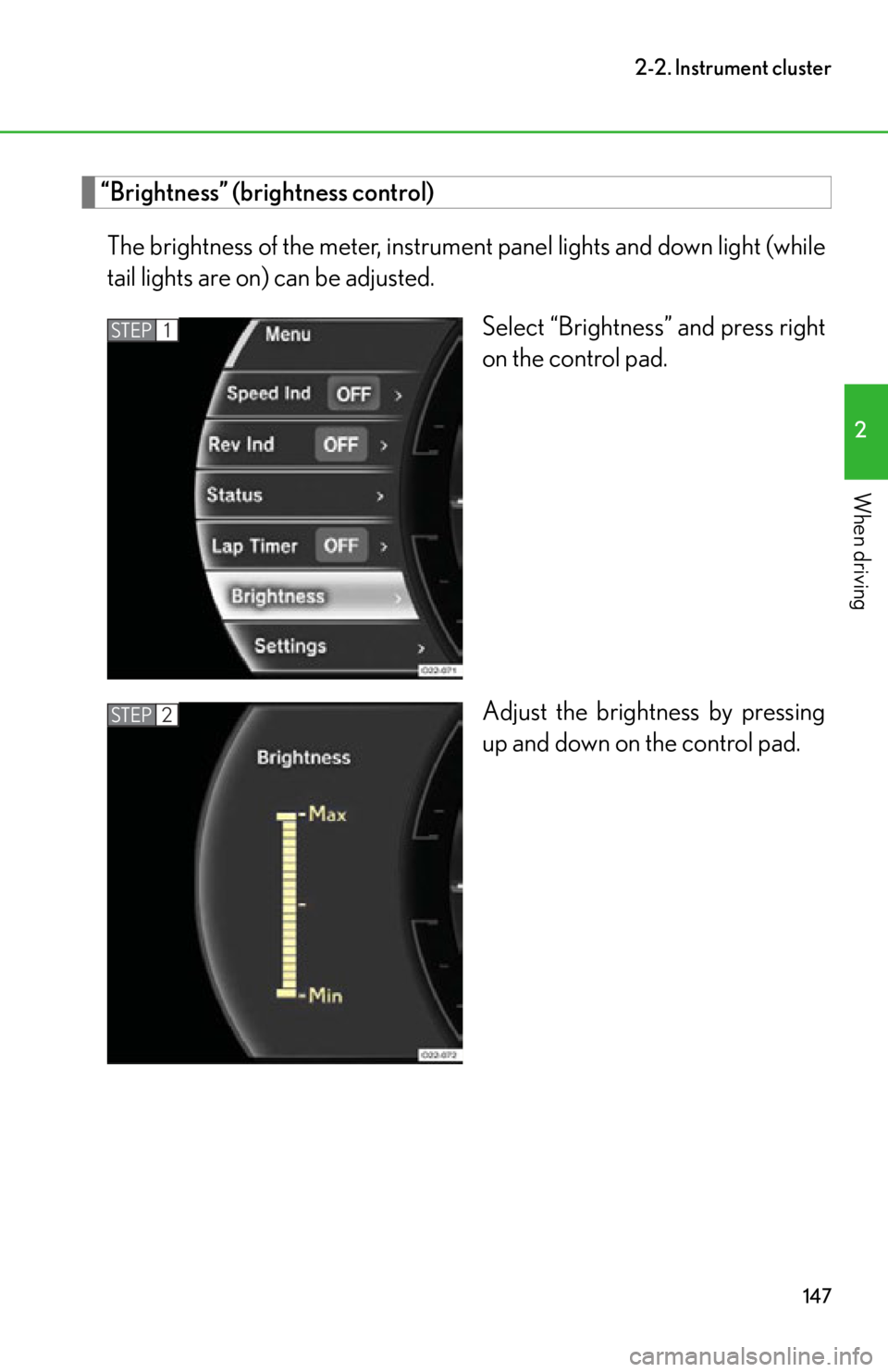
147
2-2. Instrument cluster
2
When driving
“Brightness” (brightness control)The brightness of the meter, instrument panel lights and down light (while
tail lights are on) can be adjusted. Select “Brightness” and press right
on the control pad.
Adjust the brightness by pressing
up and down on the control pad.
STEP1
STEP2
Page 160 of 420
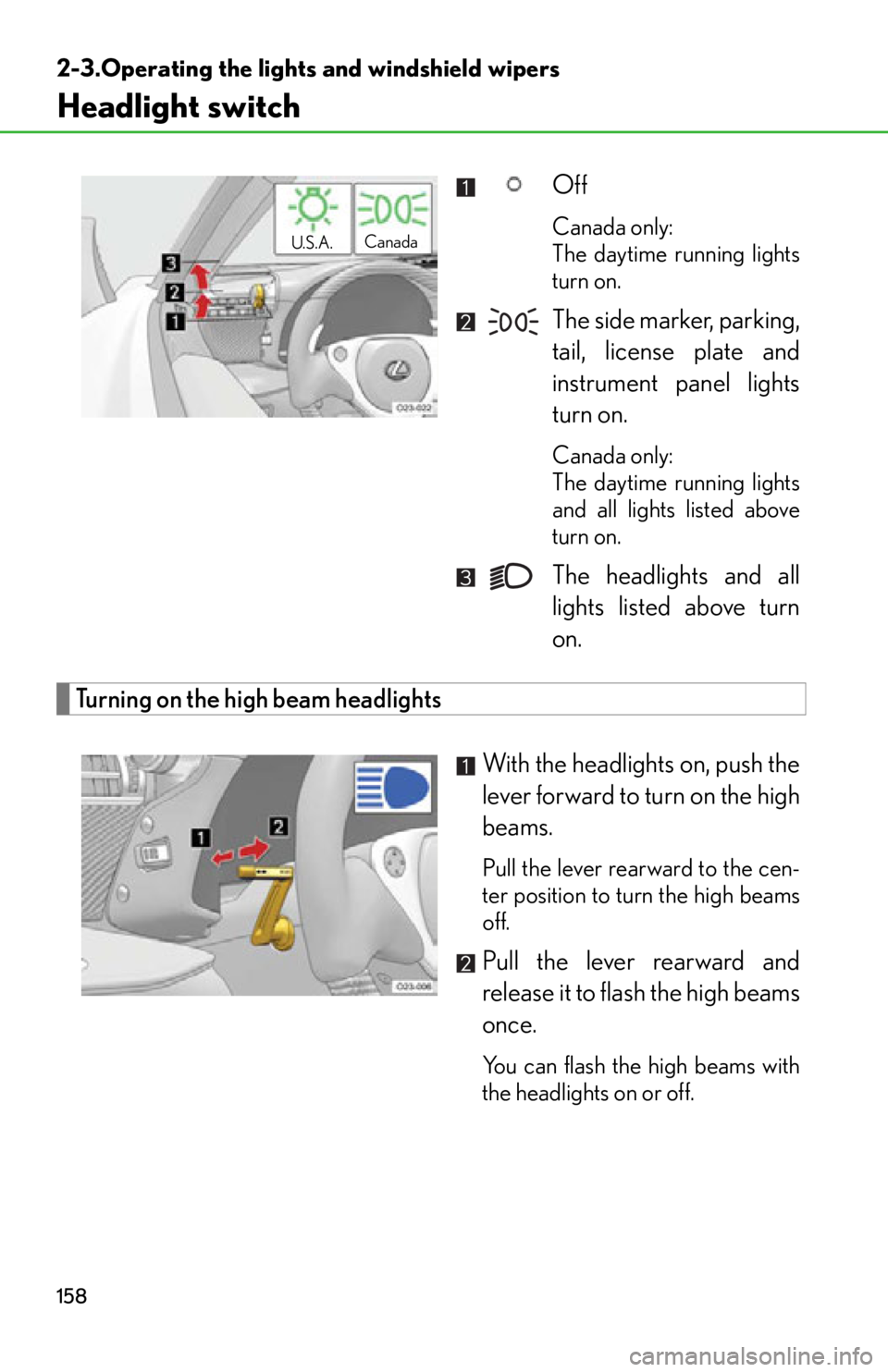
158
2-3.Operating the lights and windshield wipers
Headlight switch
Off
Canada only:
The daytime running lights
turn on.
The side marker, parking,
tail, license plate and
instrument panel lights
turn on.
Canada only:
The daytime running lights
and all lights listed above
turn on.
The headlights and all
lights listed above turn
on.
Turning on the high beam headlights
With the headlights on, push the
lever forward to turn on the high
beams.
Pull the lever rearward to the cen-
ter position to turn the high beams
off.
Pull the lever rearward and
release it to flash the high beams
once.
You can flash the high beams with
the headlights on or off.
U.S.A.Canada
Page 180 of 420

178
2-5. Driving information
CAUTION
■Things that must not be carried in the luggage compartment
The following things may cause a fire if loaded in the luggage compartment:
●Receptacles containing gasoline
●Aerosol cans
■Storage precautions
Observe the following precautions.
Failure to do so may result in death or serious injury.
●Stow cargo and luggage in the lugga ge compartment whenever possible.
●Do not place cargo or luggage in or on the following locations as the item may
get under the brake or accelerator pedal and prevent the pedals from being
depressed properly, block the driver’s vision, or hit the driver or passenger, caus-
ing an accident:
• At the feet of the driver
• On the passenger seat (when stacking items)
• On the package tray
• On the instrument panel
•On the dashboard
●Secure all items in the occupant compartment, as they may shift and injure some-
one during sudden braking, sudden swerving or an accident.
●Never allow anyone to ride in the luggage compartment. It is not designed for
passengers. The passenger should ride in th e seat with the seat belt properly fas-
tened. Otherwise, the passenger is much more likely to suffer death or serious
bodily injury, in the event of sudden br aking, sudden swerving or an accident.
■Capacity and distribution
●Do not exceed the maximum axle weight ra ting or the total vehicle weight rating.
●Even if the total load of occupant’s weight and the cargo load is less than the total
load capacity, do not apply the load unevenly. Improper loading may cause dete-
rioration of steering or braking control which may cause death or serious injury.